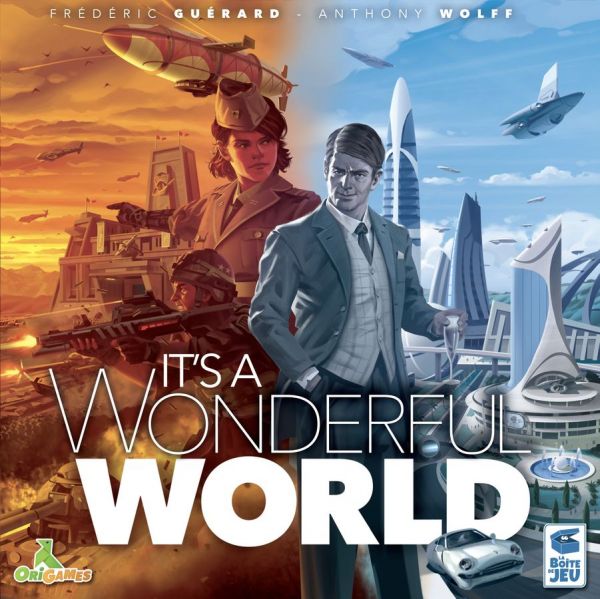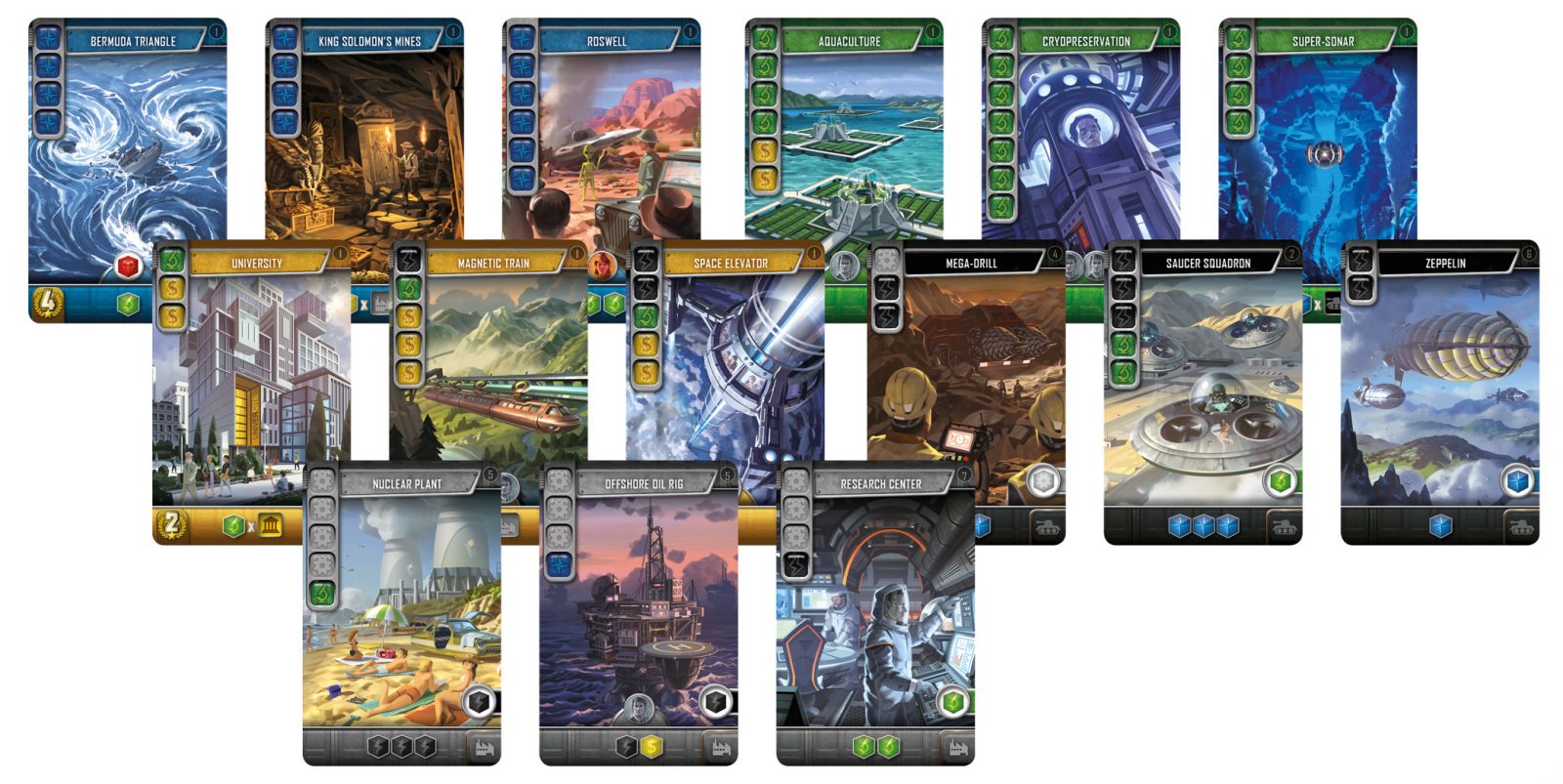Create Synergistic Empires in It's a Wonderful World

Draft the best cards to build your engine or deter your opponents in this hand management and engine-builder from designer Frédéric Guérard.
Gameplay
It’s a Wonderful World is a 1-5 player game wherein players are charged with building and advancing empires through card drafting and engine building over the course of four rounds. Each round has three phases (Drafting, Planning, and Production). Players will choose one of the five offered empire cards to choose from, each producing different resources at the end of each round, and then cards will be drafted that have the potential of joining a player’s budding empire.
Depending on the player count, how the Drafting Phase works will differ. In a 3-5 player game, each player begins with seven development cards. After each player drafts one of the cards, they will pass the rest to the player on their left or right (depending on the round). Drafting continues in this manner until all cards are picked. In a 2 player game, each player begins with 10 cards and drafts until seven cards are selected and the remaining six are discarded. In solo play, eight stacks of five cards are dealt with the player using two of these stacks per round.
Development cards are the main engine within the game. Cards represent buildings and ideas that players will be trying to build, but the cards are also the means by which players receive the resources necessary to build. Some cards, once built, will also generate resources at the end of the round, while others may produce end-game bonuses or one-time bonuses received after the card is built. Cards also contain one of five resources that, when discarded, the player receives. This is the crux of the Planning Phase as each player decides what will become part of their construction tableau and what will be recycled for resources.
These resources are important to gather but come with a caveat. As players begin to look at their cards, they will decide which cards they wish to build and which they will discard for resources. There are no penalties for leaving buildings incomplete, but large tableaus of unbuilt buildings can become unwieldy. Once players have decided their actions for the round, they will place cards to be built in front of them and then collect the resources from discarded cards starting from the left of the board and ending at the far right end. Players have two choices: place the gained resources on one of the cards in their construction tableau or place unused resources onto the empire card). Once five resources of any type have been collected on a player’s civilization card, they may turn these in for a rare Krystallium resource that can either act as a wildcard resource or may be needed to fulfil the requirements of certain building cards.
The Production phase happens last. The resources players earn from their empire cards are decided, as well as any resources from completed buildings that are added above a player’s empire card during the course of the game. This is the quickest method to fulfilling the requirements of buildings. Players may not move resources from card to card, nor can players take any resources from their empire card and use them later to fulfill a card’s requirements, so careful planning is necessary.
Producing the most resources also earns a supremacy bonus, which gifts players with a victory point chit of the representative for that resource (one of the two characters depicted on the box). These central figures are also received as construction bonuses for certain cards and may be needed to fulfil card’s construction cost.
After four rounds, players will tally the victory points of the cards they have finished building as well as any multiplier bonuses (examples include bonuses for the number of similar buildings completed, or the number of a particular victory point chit collected). The player with the highest total has built the best futuristic empire and has won the game.

Review
When Century: Spice Road hit the scene, many people were quick to call it the Splendor replacement. Though that prophecy never came to fruition, it seems apropos given that It’s a Wonderful World is poised as a would-be successor to Spice Road.
The drafting mechanic across differing player counts is great toward keeping the game’s variability and flexibility dynamic. There is not a situation or player count where the game will not accommodate variety and periphery of choice. Likewise, the base game contains 150 development cards. While many are repeats of buildings, certain cards may not show up for several games and therefore will limit players from being able to always draft the same engine from game to game. However, this can also be to the detriment of the game, as certain cards can make or break the game for some players and having little hope of those cards showing up may stall out an engine before it gets out of the gate.
Though there is no penalty for having development cards that never get completed, there are noticeable tough choices during the Planning phase that also add depth to the game. In early rounds, when each player’s engine is just getting off the ground, great cards may be discarded in hopes of gaining the necessary resources to launch their empire. That can come back and bite players who may give up a high victory point or resource generating card for the sake of getting something completed in the hopes it kickstarts their engine.
All of this is packed into a game that is quick to set up and fun to play. A solo game doesn’t take more than 20 minutes and can be as rewarding as it is crushing. A 3-5 player game runs 45-60 minutes but the simultaneous action selection of the game means no one is sitting on their hands while others suffer through someone’s analysis paralysis. The drafting mechanic also ensures there is adequate player interaction. Even if no one chooses to "hate draft" cards, players will be wise to take note of the engines the others at the table are constructing to know what others are drafting and what strategies may be to their own benefit.
Don’t let the hype of It’s a Wonderful World and the comparisons to similar-minded engine builders make you believe it will serve as a replacement to any game. However, the way it meshes its mechanics in a quick game of the highest highs and the lowest lows cannot be discounted. Though it can provide a swingy, sometimes gut-wrenching game of choice, It’s a Wonderful World has many of the hallmarks of great and accessible engine-building games and will slot nicely in any engine-building fan’s collection.
Pros: Variability in development cards and drafting, depth of choice in planning and construction of one’s tableau
Cons: Can be a swingy game due to too many development cards






